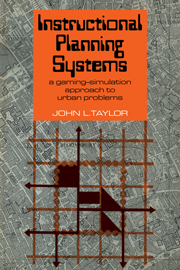Book contents
- Frontmatter
- Contents
- List of figures, tables and forms
- Acknowledgements
- 1 Point of departure
- 2 The basis for discussion
- 3 The genesis of an approach
- 4 Selected planning developments
- 5 Impact, pitfalls and pay-offs
- 6 A gaming-simulation rationale
- 7 Simulation in practice
- 8 The way ahead
- Appendices
- Bibliography
- Index
7 - Simulation in practice
Published online by Cambridge University Press: 07 May 2010
- Frontmatter
- Contents
- List of figures, tables and forms
- Acknowledgements
- 1 Point of departure
- 2 The basis for discussion
- 3 The genesis of an approach
- 4 Selected planning developments
- 5 Impact, pitfalls and pay-offs
- 6 A gaming-simulation rationale
- 7 Simulation in practice
- 8 The way ahead
- Appendices
- Bibliography
- Index
Summary
In designing and using gaming-simulation models in planning education over the last five years certain significant research and development frontiers have become clearly recognizable; these are now considered first, under three main headings connected with model selection and design, then with respect to operation procedures and finally in relation to the evaluation of instructional planning systems. Then, with these methodological considerations in mind, the chapter is concluded with a review of some of the uses and wider applications of urban development gaming which already appear to warrant greater attention.
MODEL SELECTION AND DESIGN
The starting points when selecting any teaching technique are, of course, what is to be taught, for what purpose, and at what cost. Once these have been clarified, then in theory the potential user of an instructional simulation system should be able to check what is available against his needs and then be in a position to make a selection. In practice, however, matching the would-be user's requirements with existing operational models is a difficult and lengthy process. It requires searching through an assortment of simulation reports, a tedious review of manuals and the perusal of a multiplicity of duplicated notes yet to be assembled into more cohesive operational instructions. In short, at present there appears to be no way of short-circuiting this devious process and such is the quality of much of the documentation that, even after having surveyed the literature, choosing a gaming-simulation is more an act of faith than a judicious selection of a model with the qualities appropriate to specific needs.
- Type
- Chapter
- Information
- Instructional Planning SystemsA Gaming-Simulation Approach to Urban Problems, pp. 92 - 112Publisher: Cambridge University PressPrint publication year: 1971



